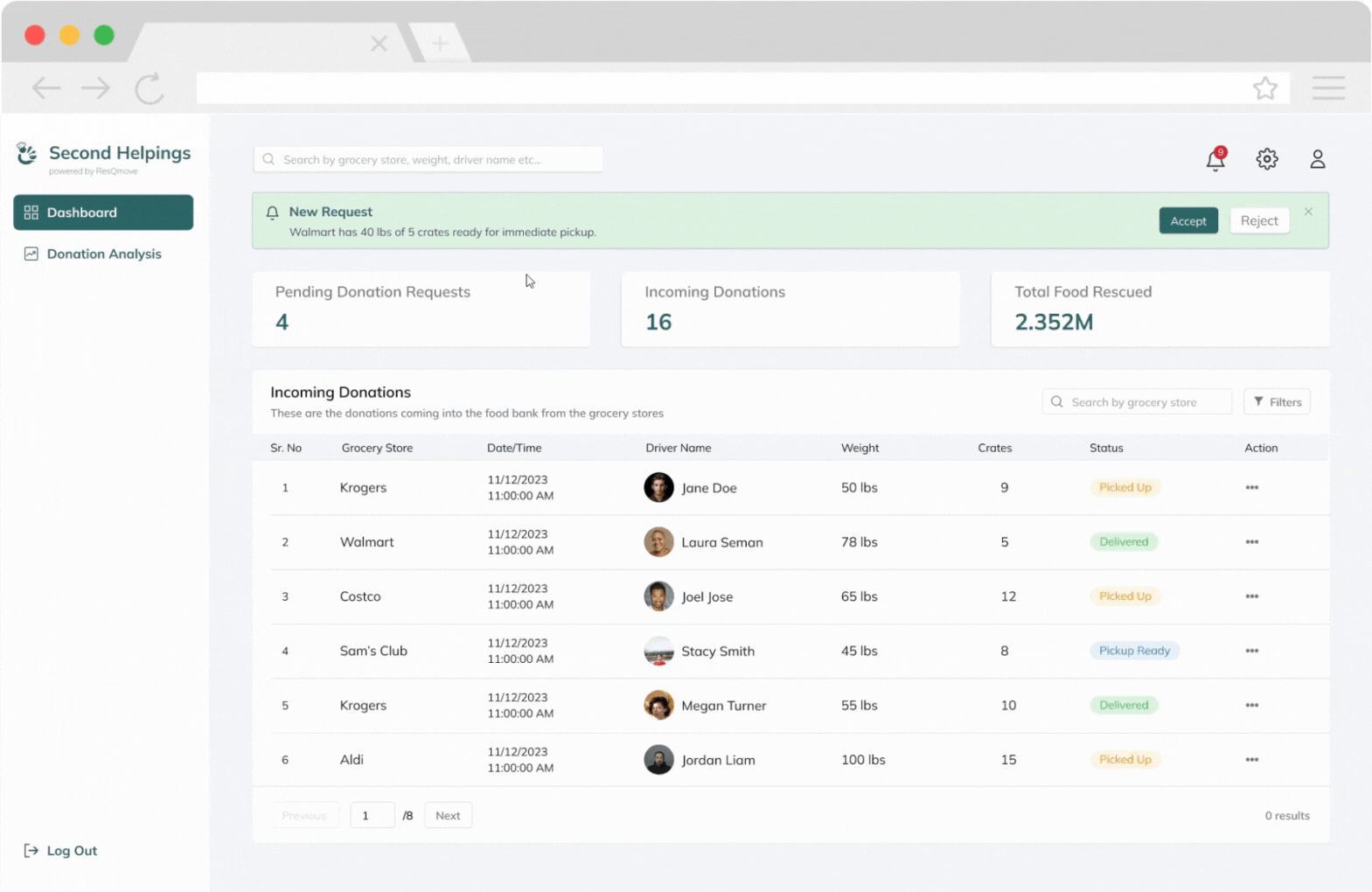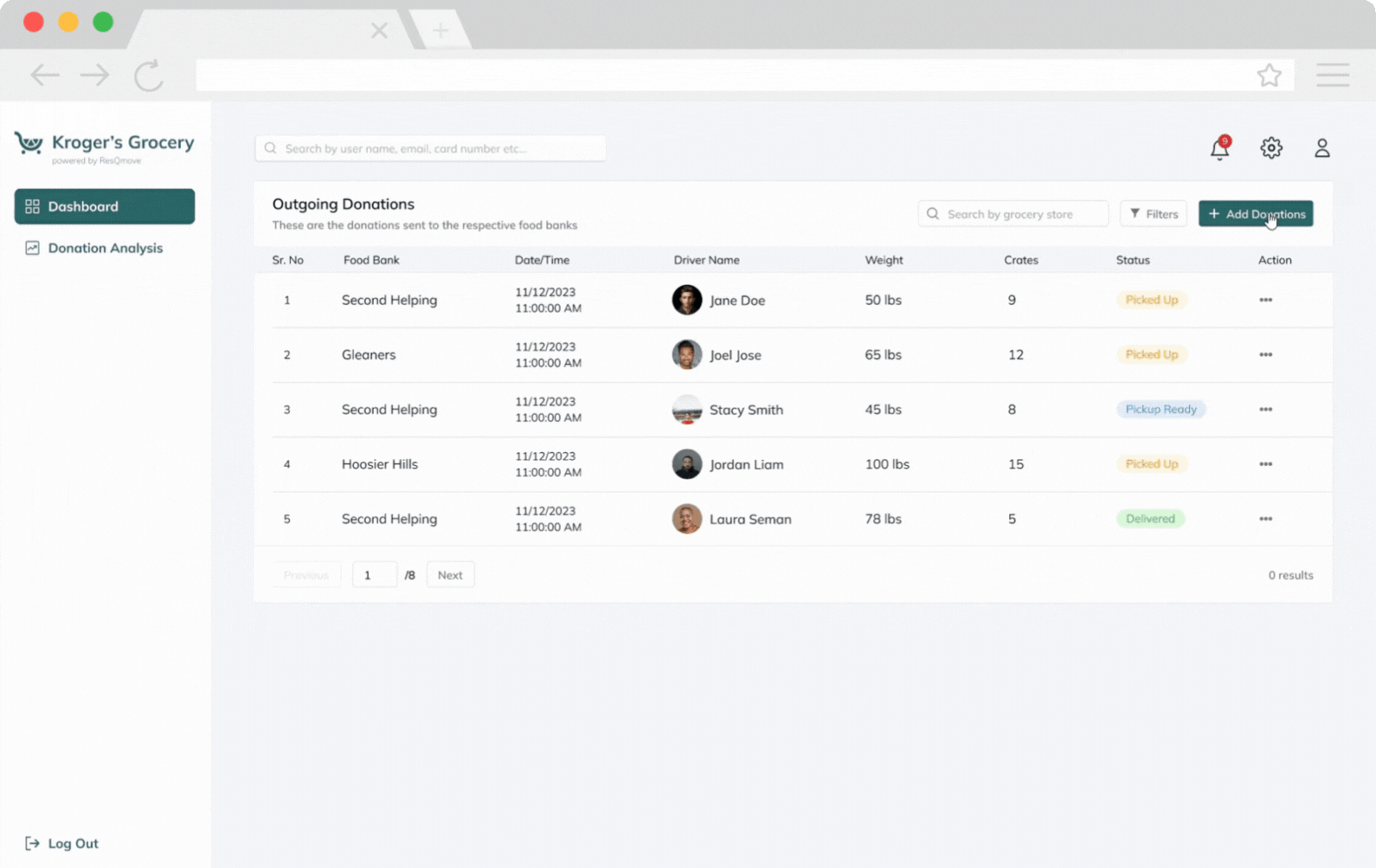A web app to streamline communication between small food banks and grocery stores to rescue surplus food

UX Research
Usability Testing
Duration
Team
Process
Role
10 Weeks
3 HCI Students
UX Research, Wireframes, UI Design, Prototyping, User Testing
As a UX Designer, I conducted stakeholder interviews, performed market research, designed dashboard screens, and conducted usability testing using think-aloud sessions as a UX Designer.
About the Product
Food banks in Indiana often struggle to access available surplus food from grocery stores due to limited transportation resources and inefficient communication.
Groceries tell nearby banks about surplus food, small food banks accept/decline, then nearby drivers pick up and trackable delivery happens.

Problem Statement
How might we help small food banks improve communication to obtain food information while enhancing logistics in Indiana State?
Success Metrics:

User Segment
The main users, aged 18-55, manage small food banks facing communication and transportation challenges. Secondary users include grocery stores and transport service personnel assisting in food rescue efforts.
Process
Initiated with Stakeholder Interviews.
Concluded with Usability Tests involving Grocery Stores and Food Banks to maximize business impact.

Research
What is food insecurity?
Food insecurity is the unavailability of food, and people struggle to get the food they need because it's either hard to find, too expensive, or not the right kind of food.

Food Insecurity in USA
44 million
people in the US Face food insecurity
13.5%
households in Indiana experience food insecurity
13%
population in Marion County were food insecure
Let's Understand how food network works in USA
In the United States, the food network hierarchy operates on a pyramid structure, where ascending levels indicate an increase in resources available for food banks.

According to Feeding America in 2022, estimates approximately 1 in 6 received charitable food assistance

Places we visited to take Interview


.jpeg)


Snippets from Interview and Observation


















MEET DAVID!
Age: 30 Years
He works at a small foodbank and manages the transportation and communication with the grocery stores to get surplus food.



His Duties Include
-
Collecting surplus food from the grocery stores
-
Inventory Management
-
Looking for volunteers to run the food bank more efficiently

However, several key problems stand in his way
-
Communication Gap
-
Large food banks are intermediaries in the system
-
Delay viewing emails regarding surplus food
-
Inefficiency in Handling Perishables
-
Late pickups of surplus food

-
Limited Transport Availability
-
Insufficient rescue trucks.
-
Limited funds to buy an automobile.
Secondary Research
Food banks exacerbated by the supply-chain crisis
We are facing a shortage of transport vehicles to get food to the food bank
This statement highlights the limited truck availability barrier for food banks face.
"According to Garbage Removal & Trash Pick up for Grocery Stores | RTS.” Recycle Track Systems,
about 30 percent of food in American grocery stores is thrown away.
which says that about 16 billion pounds of food waste every year is generated by US retail stores.
Similar issues are encountered by 139 food banks in Indiana
Brainstorming
As a team, we engaged in collaborative brainstorming to efficiently refine the design suggestions.

Information Architecture


Mid-Fidelity Wireframes






Solution
ResQmove streamlines the donation process between grocery stores and food banks. Grocery stores notify nearby food banks of surplus food, specifying details. Food banks decide to accept or decline, and if accepted, the system assigns the nearest Transport Service driver. The driver receives pickup details, and both the store and food bank track the driver's progress. Upon completion, a system log records for a successful delivery.

To streamline surplus food transport
I remembered a key takeaway from the interview with a major food bank utilizing Amazon Flex services.
Amazon Flex lets people use their cars to deliver packages for extra cash. We can integrate Amazon Flex as a transportation solution to get surplus food from grocery stores to the food banks.
They can get tax rebates for their donations of up to 30% depending on the charity.


Impact of the Solution
The solution eliminates large food banks (Gleaners) from the picture. Grocery stores and Small Food Banks can directly communicate on ResQmove.
Amazon Flex serves as a solution to limited transport completing the cycle for the solution
Final Designs
Grocery Store Flow
The screen shows the working for the Grocery Store Dashboard. The user clicks on "Add Donation", scans the food donation, adds the pick-up time and posts it on the platform.

Food Bank Flow
Small food banks will receive requests from grocery stores, view notifications, and access analyses on individual donors.



Amazon Fex Flow
The transport service receives trip confirmations from small food banks, navigates using the app, and completes donation deliveries.
Usability Testing
The UI underwent multiple evaluation methods, such as Heuristic evaluation, Think-aloud, SUS reports
and the customer satisfaction for the solution was rated 3.5 out of 5.
Think-aloud Session:
Think-aloud sessions with stakeholders revealed a smooth task completion rate of 85%. Based on insights gained, the design team iterated to address the issues raised by stakeholders by displaying information on the dashboard to facilitate better decision-making regarding requests.
System Usability Scale (SUS) Score:
The mean SUS score for the applications think aloud is 82.5.
Considering industrial standards to be 70, our average SUS score is 82.5 showcasing some room for minor improvements to enhance the satisfaction of the users while using the application.
Based on the findings, necessary changes were made to the UI.
Add Food Category
The user must have the option to enter the type of food they are donating. To accommodate the transport vehicle and the food bank receiving it.

Before

After
Posting Notes
Before posting a donation the grocery store can add notes to address any special instruction the driver needs to follow in order to collect the food.

Before

After
Learnings
-
Iterations on research to make efficient solutions are necessary.
-
User testing is essential for evaluating, and improving designs.
-
Efficient teamwork and collaboration are crucial for fostering diverse ideas.